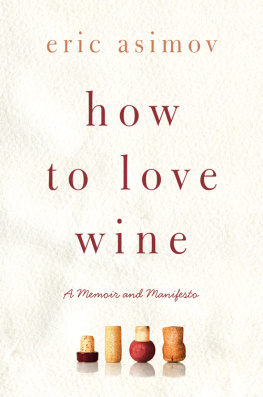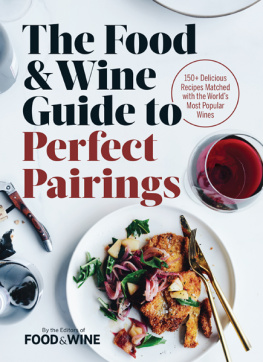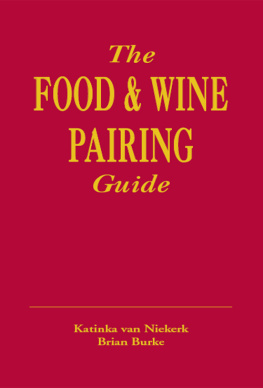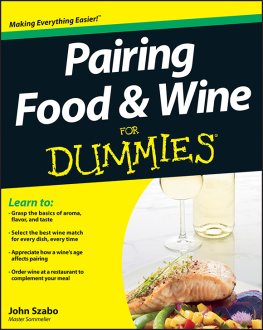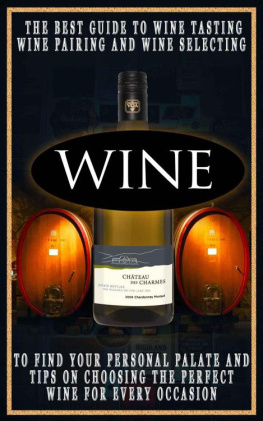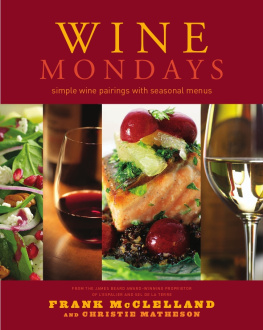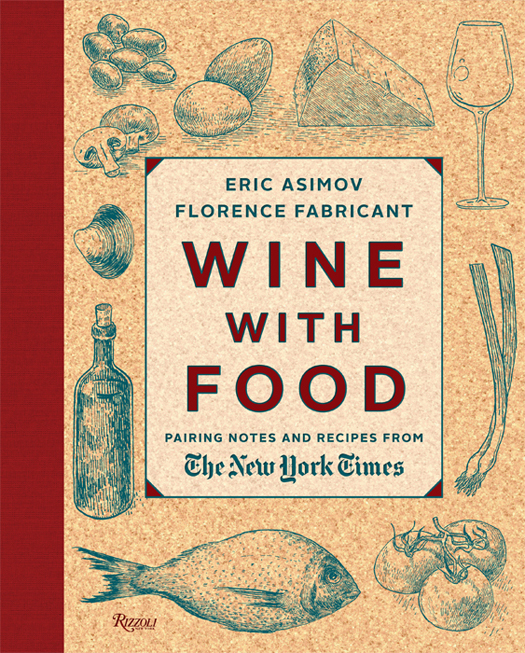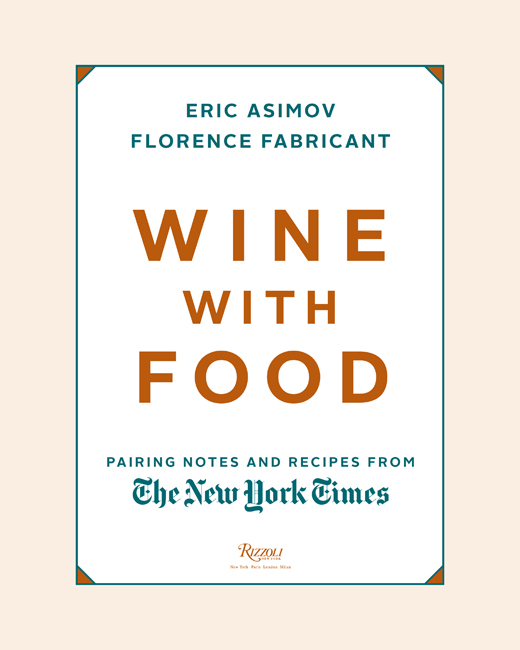First published in hardcover in the United States of America in 2014 by Rizzoli International Publications, Inc.
300 Park Avenue South
New York, NY 10010
www.rizzoliusa.com
2014 The New York Times Company
This ebook edition 2014 The New York Times Company
All rights reserved. No part of this publication may be reproduced, stored in a retrieval system, or transmitted in any form or by any means, electronic, mechanical, photocopying, recording, or otherwise, without prior consent of the publishers.
Illustrations by Zachary Hewitt
eBook ISBN: 978-0-8478-4473-9
Hardcover ISBN: 978-0-8478-4221-6
v3.1
P RAISE FOR E RIC A SIMOV S PREVIOUS BOOK , How to Love Wine:
Eric Asimov sees through the snobby froth of 100-point scores and tutti-frutti tasting notes to the realities of wine, staple grocery and occasional star, as he calls it.
H UGH J OHNSON
A friendly, well-written approach to enjoying wine, full of low-stress recommendations to help avoid wine anxiety.
Kirkus Reviews
Wine fanatics, or those angling for entry to the world of wine, will find comfort in Asimovs downtoearth discussion of loving wine.
Booklist
P RAISE FOR F LORENCE F ABRICANT S PREVIOUS BOOKS :
For The New York Times Restaurant Cookbook:
This book is a delicious tribute to the wonderful spirit of these restaurants, and to everyone from the dishwashers to the cooks, chefs, and restaurateurs who make these restaurants possible.
T IM Z AGAT
For The New York Times Seafood Cookbook:
The recipes are streamlined and reliable. A solid introduction provides tips and makes this generally excellent volume even more useful.
Publishers Weekly
For Park Avenue Potluck:
A lovely collection of recipes from some of New York societys grandest dames.
O, The Oprah Magazine
For Jack and Peter,
may they always be blessed with pleasures at the table
ERIC ASIMOV
For Richard,
ever the willing taster and critic
FLORENCE FABRICANT
CONTENTS
INTRODUCTION
BY ERIC ASIMOV
WE RE PRIVILEGED TO LIVE IN THE GREATEST TIME IN HISTORY TO DRINK WINE . We now have access to a wider diversity of wines than ever before, made in more styles, from grapes unheard of twenty years ago, grown in places never before associated with good wine. The sheer volume of choices will thrill the intrepid wine explorer. The more hesitant may find themselves paralyzed by the torrent of unfamiliar labels and names.
This book is intended to encourage exploration by making the case that with wine, its really hard to make a mistake. You will undoubtedly find some wines you like better than others. You will find other wines that you cant abide, despite what the experts say. You will not always agree with Florence Fabricant and me. Why, we dont always agree with each other.
Thats how we all learn, by drinking and thinking. Consuming wine without reflection is fine, so long as your intention is simply to enjoy the moment without building your knowledge. Reading books or taking classes without drinking is about as useful as trying to learn the piano without an instrument. The accumulation of practical experiencethat is, opening bottles and drinking winealong with a modest effort to record your reactions to the wines is the surest way to develop a sense of ease and comfort in this ever-expanding world.
By this way of thinking, you do not risk making wrong choices. You are simply adding to your body of experiences. Of course, nobody wants to open a bottle that does not satisfy. But even unappealing bottles teach us something about our own tastes. The long-term benefits of experience far outweigh the transitory disappointments.
I would make the same argument about pairing wine and food, a fairly simple and pleasant procedure that has been made to seem arcane and complicated by well-meaning guidebooks and treatises. Just as experience in the kitchen leads good home cooks to overcome an initially slavish obedience to recipes, the repeated exercise of picking a wine for dinner will help conquer self-doubt and develop an instinctive sense of what works.
You will see that each type of wine discussed in this book is accompanied by one or more recipes. But the last thing that either Florence or I want to convey is that you must be bound by these suggested pairings. Nothing could be further from the truth. A description of a good wine represents a snapshot, freezing one moment in a bottles evolution, and a proposed pairing reflects only one point on the spectrum of possibilities. Some ideas may be precisely to your taste, and some not. Suggesting wine pairings should never inhibit an impulse to explore.
The only danger is the fear of making a mistake. Seriously bad choices are rare. I once wrote a column about drinking red wine with oysters, an unorthodox approach that at the time seemed to be fashionable in Paris. In the conventional wisdom, nobody in his right mind would pair reds with raw oysters, not with so many pleasurable tried-and-true white choices like Muscadet, Chablis, and Sancerre. But I tried a selection of red wines. None were horrendous. A few were quite pleasurable. Would I reach for a Chinon, for example, over a Muscadet? Not by choice. But it wouldnt be a disaster if I did. I know people who swear that nothing goes with steak better than an aged auslese riesling. Really? I havent tried it yet, though if I did, I would keep a good red in reserve. But I am open to the possibility. The point is this: Pairing is an exploration. Even less felicitous matches have something to teach. The only time it is truly important to match food and wine with painstaking care is with a rare, delicate, and expensive bottle, when it would be a shame to miss out on the wines nuances and complexities. In those cases, simple, classic pairings are often best.
It is easy to see why the notion of food-and-wine pairing makes people crazy. For one thing, simple but overly broad rules of thumbwhites with fish, reds with meathave devolved into how- to tomes full of complicated charts, classifications, and materials to memorize. Sometimes, the discussion of complex wine characteristics like body, tannins, pH, and so on is juxtaposed against basic information (its pronounced PEE-noh GREE-joe), suggesting perhaps that novices can easily grasp and benefit from byzantine pairing guidelines.
Im sorry, but the truth is that experience is the only surefire method for feeling more at ease with wine and food. To learn how to ski, you must set off down the mountain and not be afraid to fall. And falls happen, even with the experts.
Sommeliers and chefs handle pairings differently than the rest of us, as they should. I can think of any number of red wines that I would love to drink with a good hamburger: Beaujolais, Chianti, a California syrah inspired by the northern Rhne, dolcettoIm not picky. I would look to see what was around and decide which of the available bottles I would enjoy drinking the most. Simple. For the professionals, it would be something far more obsessively analytical: Is the beef lean, or does it have a high percentage of fat? What are the toppings? Ketchup? Mustard? If pickles, sour or sweet? Black pepper or white? Cheddar or Swiss? What sort of salt? What about the bread? Sourdough? Seeded?
I expect that when I take a sommeliers suggestion in a restaurant it is the result of dedicated fact-finding, tasting through all sorts of combinations with antennas out for the barest of nuances. But just as I dont cook like a restaurant chef at home, I dont want to pick wines like a sommelier. So I act on instinct and learn something each time. Most of us prefer a more casual approach, free of anxiety, I suspect. So take our suggestions. Theyre good ones. But better yet, explore for yourself and enjoy the journey.


